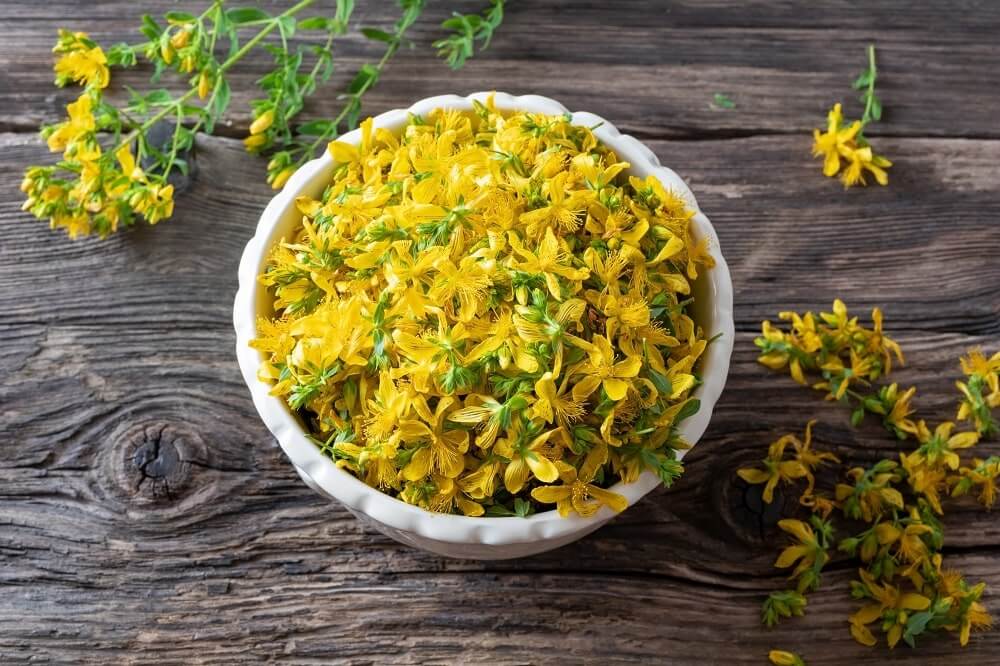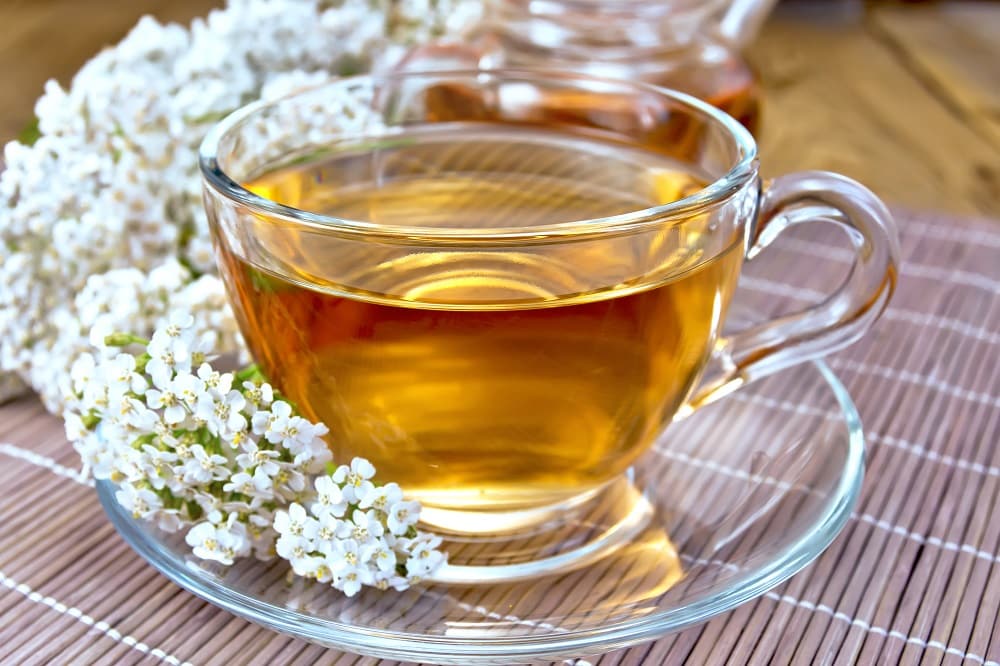Not only are plants and flowers beautiful and enhance your landscaping, but numerous plants provide medicinal benefits as well. Down to Earth Services are the native plant specialists in Kansas City, and we have so much to share, including the best medicinal plants to grow in your garden. Even a novice gardener will be able to concoct various essential home remedies such as oils, salves, and teas when growing the following ten medicinal herbs in their garden.
The 10 Easy-To-Grow Medicinal Plants for Your Garden
1. Cinquefoil
Cinquefoil (Potentilla simplex) has long been considered a powerful medicine used to treat ailments such as sore throats, pimples, sunburn, muscle spasms, and more. Cinquefoil is easy to grow and blooms all summer long. This plant is related to the strawberry family and is also known as barren strawberries. The flowers of cinquefoil can vary in color, but the most common color is yellow.

This beauty also makes a delicious tea. Some of the benefits of cinquefoil include anti-inflammatory properties. They can be used as a diuretic, reducing menstrual pain, controlling bleeding, insect bites, used as an antispasmodic, and can be helpful as a cold or flu therapy. This plant contains calcium, iron, and magnesium and is mainly used as a medicine source and is a survival herb.
2. Sunflower
Many people consider the sunflower (Helianthus annuus) to be a beautiful flower that blooms in blooms from May to November. The seeds of the sunflower are known as a tasty snack. Sunflower seeds are in almost every grocery store you visit. Additional uses for the sunflower are baking bread, cakes, a coffee substitute, and more. From a medicinal standpoint, the sunflower leaves can be made into a tea that acts as an astringent, expectorant, diuretic, used to treat fevers, malaria, and some lung ailments. The leaves can also be crushed into a poultice to treat swelling, sores, spider bites, and snake bites.
In addition to the above uses for sunflowers, they help with arthritis, gastroenteritis, pulmonary pneumonia, whooping cough, colds, and headaches, to name a few. This medicinal plant is highly versatile and one to consider when planting a medicine garden.
3. Echinacea
Native Americans have used echinacea (Echinacea angustifolia) for years as a treatment for various ailments. Today, most people will purchase this medicinal plant as an herbal remedy for the flu or common cold. The echinacea plant is high in antioxidants, reduces anxiety, helps treat skin issues, offers protection against cancer, and contains anti-inflammatory properties.

4. Marigold
Experienced gardeners have used marigold (Asterales) for companion planting, attracting beneficial insects, and nematode control. However, it has also played an essential role in North/South America and Mexico’s early medicines. Today, the primary use of Marigold is as a source of carotenoids, zeaxanthin, and lutein, for supporting healthy vision. It can also be used as a topical application to support foot health. The extract can be found in ointments, oils, and tinctures.
5. Red Mulberry
Red mulberries (Morus rubra) have many uses, such as jelly, pie, fruit, wine, tea, and other drinks types. Ripe fruit will be purplish. Consuming unripe fruit can cause stomach upset and hallucinations. From a medicinal point of view, the root bark is anthelmintic and cathartic. Used as a tea, it can help treat weakness, dysentery, reduce hay fever and panacea.

6. Spiderwort
The ‘wort’ portion of the spiderwort’s (Tradescantia) name is an old English term meaning having the knowledge of the various uses of a plant. You can put both the root and flower of this plant to use in herbal medicines. Native Americans used it to cure venomous spider bites with spiderwort. They also made it into an herbal drink for menstrual pain. However, many use it today as a laxative or to help treat kidney and stomach issues. For years, it has been used as a poultice by crushing the leaves to treat insect stings and bites.
7. St. John’s Wort
It is important to note that St. John’s wort (Hypericum perforatum) can react negatively with other medications, and therefore it is vital to research these interactions before taking the herb. The most common use for St. John’s wort is mood disorders and depression. It can also help to relieve the symptoms of menopause. The majority of people who take St. John’s wort will consume anywhere between 400 to 1200 mg each day. The product is typically purchased as a pill or as an oil.

8. Skullcap
Skullcap (Scuttellaria incana) is a flowering plant from the mint family. Native Americans and Chinese have both used it as a traditional medicine to treat various ailments. Today, you can purchase skullcap in supplement form. The Chinese used the plant’s dried roots to treat insomnia, diarrhea, high blood pressure, dysentery, inflammation, and respiratory infections. Skullcap comes in powders, capsules, and liquid extracts.
9. Purple Coneflower
Purple coneflower, referred to as echinacea (Echinacea purpurea), is a gorgeous purplish flower. Some of these flower’s uses are making essential oils, herbal remedies, tea, and herbal supplements. The tea provides a tingling feeling that is both invigorating and refreshing. Many herbal tea manufacturers combine it with mint and lemongrass to offer a unique yet pleasant flavor that is smoother to drink

Purple coneflower is one of the best medicinal plants and offers a variety of excellent health benefits. It helps prevent infection, boost immunity, relieve pain, soothe respiratory ailments, and improve mood swings. The tea is easy to make by using a handful of purple cauliflower leaves, 10 ounces of water, and an optional sweetener, such as honey. It is a great product to have on hand during the cold season. This soothing beverage will help ease the uncomfortable feeling of a sore throat as the weather gets cold.
10. Yarrow
Last on our list of types of medicinal plants is yarrow. Yarrow (Achillea millefolium) is another plant that has been used as a traditional medicine for many centuries. It also has been commonly known as carpenter’s weed, Devil’s nettle, bloodwort, old man’s pepper, thousand-leaf, staunch weed, and woundwort. Some of the benefits of yarrow include reducing inflammation, wound healing, anxiety, digestive disorders, and neurological conditions. All of the above benefits have a rich history of medicinal use and are suggested through various scientific studies. Other possible uses include alleviating hay fever, supporting immune systems, regulating blood sugars, treating hemorrhoids, speeding up the elimination of urine, stimulating menstruation, and helping with sleep disorders.

Last Thoughts on Medicinal Plants to Grow in Your Garden
Remember, you will not need a large plot of land or a green thumb to reap the benefits of growing fresh, medicinal herbs in your garden. Medicinal plants provide a wealth of benefits for your family’s garden while at the same time adding a rainbow of colors and alluring aromas. A medicinal herb garden can be grown anywhere, including a kitchen window box, pots on the patio, or a small backyard garden plot. Down to Earth Services is here to help with all of your plant and gardening questions and projects.


